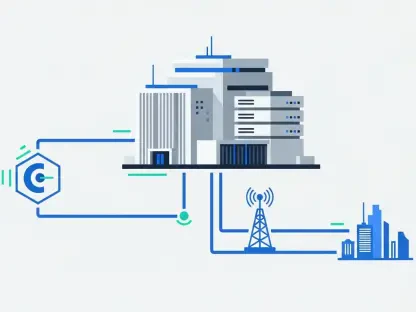In an era where digital connectivity underpins global economies and national security, the undersea cable market stands as a linchpin of modern infrastructure, witnessing an extraordinary boom fueled by escalating data demands, geopolitical complexities, and rapid technological evolution. These submarine cables, carrying over 70% of the world’s internet traffic, are no longer mere conduits for communication but have emerged as strategic assets critical to both economic stability and defense priorities. With projections estimating global data traffic to surpass 12 zettabytes annually by 2030, the urgency to expand and secure this underwater network has never been more pronounced. This market, valued at a potential $44.33 billion by 2030 with a steady growth rate of 5.6% annually from now, presents a compelling landscape for investors seeking to tap into both technological innovation and security-driven opportunities. The intersection of cutting-edge advancements and geopolitical stakes makes this sector a focal point for strategic financial moves.
Market Drivers and Growth Potential
Data Explosion and Technological Advancements
The undersea cable market is experiencing a seismic shift, propelled by an unprecedented surge in global data traffic driven by the widespread adoption of artificial intelligence, cloud computing, and 5G networks across industries. Hyperscalers, such as major tech giants, are pouring significant resources into self-funded trans-oceanic cable systems to handle their massive data workloads, ensuring low-latency connectivity for users worldwide. Innovations like Space Division Multiplexing (SDM) and high-fiber-pair technologies are revolutionizing the sector by drastically reducing the cost per terabit, making large-scale expansions not only feasible but also economically viable. This technological leap forward is critical as submarine cable systems alone are expected to reach a market value of $24.18 billion by 2030, growing at an impressive 10.2% annually. The relentless demand for bandwidth underscores the market’s robust growth trajectory, positioning it as a cornerstone of the digital economy with vast investment potential.
Beyond the raw numbers, the focus on scalability and efficiency in undersea cable infrastructure highlights a broader trend of adapting to future data needs with smarter solutions. Companies are racing to deploy systems that can handle exponential increases in traffic while maintaining reliability, a challenge that has spurred partnerships between tech leaders and infrastructure providers. The push for higher capacity cables is also reshaping supply chains, with manufacturers innovating to meet the stringent demands of underwater environments. This dynamic environment is fostering a competitive edge among firms that can deliver both speed and durability, ensuring that data flows seamlessly across continents. For investors, this translates into opportunities to back entities that are not just riding the wave of digital transformation but actively shaping its infrastructure backbone, promising substantial returns as global connectivity needs continue to soar.
Sustainability as a Market Catalyst
Energy efficiency has emerged as a pivotal factor in the undersea cable market, with sustainable practices becoming a significant driver of growth and investor interest in this high-stakes sector. Underwater data centers, leveraging natural cooling from ocean depths, can reduce energy consumption by up to 50% compared to their land-based counterparts, offering a compelling solution to the industry’s environmental footprint. Their strategic placement near offshore wind farms further enhances their green credentials by integrating renewable energy sources, aligning with global decarbonization goals. This focus on sustainability not only addresses regulatory pressures but also appeals to a growing cohort of environmentally conscious stakeholders who prioritize eco-friendly investments. The dual benefit of cost savings and reduced carbon emissions positions sustainable infrastructure as a transformative force in the market.
Moreover, the shift toward greener technologies in undersea cable systems reflects a broader industry commitment to balancing growth with environmental responsibility, a trend that is reshaping project planning and execution. Governments and private entities are increasingly incentivizing projects that incorporate renewable energy, creating a favorable landscape for companies that innovate in this space. This alignment with sustainability goals is not just a moral imperative but a strategic one, as it opens access to funding and partnerships focused on long-term ecological impact. The market’s evolution toward energy-efficient solutions also mitigates operational risks associated with rising energy costs, providing a buffer against economic volatility. For those looking to invest, the emphasis on sustainability offers a unique angle to support firms that are future-proofing their operations while contributing to a more sustainable digital infrastructure globally.
Geopolitical and Security Imperatives
National Security and Cybersecurity Focus
As undersea cables carry the bulk of international data, their role as critical national security assets has come under intense scrutiny, prompting governments to implement stringent measures to protect these vital networks. The U.S. Federal Communications Commission (FCC) has introduced enhanced licensing and cybersecurity protocols to safeguard against potential threats, reflecting a growing recognition of these cables as targets for sabotage or espionage. Concerns over foreign influence, particularly from authoritarian regimes seeking control over physical internet infrastructure, have heightened the urgency for robust security frameworks. This has led to calls for stronger alliances between the U.S. and European nations to establish unified global standards, ensuring that these underwater lifelines remain secure. The intersection of technology and geopolitics is thus driving a surge in investments aimed at fortifying digital borders.
The escalating focus on cybersecurity within the undersea cable market also underscores the need for advanced protective technologies capable of countering sophisticated threats in real time. Companies are being pushed to integrate quantum-resistant encryption and other cutting-edge solutions to shield data from interception or disruption, a necessity in an era of increasing digital warfare. Regulatory bodies are not only tightening oversight but also collaborating with private sectors to develop resilience strategies against both natural and intentional disruptions. This evolving landscape adds a layer of complexity to infrastructure projects, as compliance with security mandates often increases costs and timelines. However, it also creates a fertile ground for investment in firms specializing in secure connectivity, as their expertise becomes indispensable to maintaining the integrity of global communication networks amid rising geopolitical tensions.
Defense-Oriented Investment Opportunities
The undersea cable market’s alignment with defense priorities has spotlighted specific telecom and cloud stocks as prime targets for investors seeking to capitalize on both growth and strategic importance. Companies like Lumen Technologies (LUMN), Nokia (NOK), and Alcatel Submarine Networks (ASN) are leading the charge, blending commercial innovation with national security imperatives through high-profile projects and government contracts. Lumen’s involvement in the JUNO Trans-Pacific Cable System, a 20-fiber-pair, 350 Tbps network connecting Japan and the U.S., exemplifies this dual focus, contributing to a notable 6.75% surge in its share price recently. Additionally, a $196.5 million contract with the U.S. Defense Department to manage dark fiber through 2028 further solidifies Lumen’s pivotal role in defense-oriented telecom resilience, making it a standout choice for investment portfolios.
Nokia, on the other hand, is carving a niche with initiatives like the Medusa Submarine Cable System, enhancing connectivity between North Africa and Europe through advanced optical technologies tailored for security. Its emphasis on quantum-resistant cybersecurity aligns directly with defense needs, positioning it as a frontrunner in intelligent infrastructure that can withstand emerging threats. Meanwhile, Alcatel Submarine Networks dominates in cable installation and repair, having laid extensive kilometers of underwater systems in recent years, despite facing supply chain hurdles. These companies collectively represent a spectrum of opportunities, each addressing unique aspects of the market while contributing to national security goals. Investors are increasingly drawn to such firms for their ability to deliver robust returns while playing a critical role in safeguarding global digital infrastructure against geopolitical risks.
Key Players and Strategic Investments
Leading Companies in the Spotlight
Among the frontrunners in the undersea cable market, Lumen Technologies (LUMN) stands out with its ambitious projects and deep ties to defense initiatives, making it a compelling option for strategic investments. The company’s role in the JUNO Trans-Pacific Cable System, boasting a capacity of 350 Tbps across 20 fiber pairs, not only enhances global connectivity but also strengthens critical links between key allies like Japan and the U.S. Beyond this, Lumen’s recent $8.5 billion in deals for Private Connectivity Fabric (PCF) solutions and a substantial $196.5 million contract with the U.S. Defense Department highlight its integral position in securing national interests. This blend of commercial success and governmental collaboration has driven tangible growth in its market valuation, reflecting investor confidence in its dual-purpose capabilities. Lumen’s trajectory illustrates the potential for significant returns in a sector where security and innovation intersect.
Nokia (NOK) also commands attention with its forward-thinking approach to undersea infrastructure, particularly through projects like the Medusa Submarine Cable System, which bolsters connectivity across strategic regions. By leveraging advanced optical technologies and prioritizing quantum-resistant cybersecurity, Nokia addresses pressing defense concerns while meeting commercial data demands, a balance that enhances its appeal to investors. Its commitment to creating intelligent, secure networks positions it as a leader in a market increasingly defined by geopolitical stakes. This focus on cutting-edge solutions not only mitigates risks associated with data breaches or sabotage but also aligns with global efforts to protect critical infrastructure. For those eyeing long-term growth, Nokia represents a strategic bet on a company that is shaping the future of secure, high-capacity underwater connectivity across diverse geopolitical landscapes.
Emerging Innovators and Market Niches
In addition to established giants, emerging players like Ciena (CIEN), Lumentum (LITE), and CommScope (COMM) are making significant inroads in the undersea cable market by focusing on specialized technologies tied to 5G and AI-driven fiber optics. Ciena, despite grappling with margin pressures due to rising production costs, remains a key contributor to high-capacity submarine systems, benefiting from the sector’s projected 12.6% annual growth in demand. Its expertise in optical networking solutions supports the scalability required for modern data traffic, positioning it as a valuable, if challenging, investment prospect. The company’s ability to innovate amidst financial constraints highlights a broader trend of resilience among tech firms adapting to the unique demands of underwater infrastructure, offering a niche opportunity for those willing to navigate short-term volatility for long-term gains.
Lumentum (LITE) and CommScope (COMM), meanwhile, are tapping into distinct segments of the market, with Lumentum shifting focus to advanced transceivers critical for high-speed data transmission, and CommScope securing global infrastructure contracts that bolster its presence in submarine cable deployment. Both companies are well-placed to capitalize on the escalating need for robust connectivity solutions driven by AI and 5G applications, despite facing competitive pressures. Their specialized contributions cater to specific technical needs within the broader undersea ecosystem, creating diversified avenues for investment. As the market evolves, these firms exemplify how targeted innovation can carve out profitable niches, even in a landscape dominated by larger players. Investors looking to balance risk with potential rewards may find these emerging innovators particularly appealing for building a well-rounded portfolio in this dynamic sector.
Challenges and Innovative Solutions
Obstacles in Deployment and Maintenance
The undersea cable market, while brimming with potential, faces formidable challenges that test the resilience and ingenuity of industry players, particularly in the realms of deployment and ongoing maintenance. High initial costs for laying cables across vast oceanic expanses remain a significant barrier, often running into billions of dollars for major transcontinental projects, which can deter smaller firms from entering the space. Geopolitical vetoes on certain routes, driven by national security concerns or international disputes, further complicate project timelines and inflate expenses. Additionally, the inherent risks of natural disasters, such as earthquakes, or deliberate acts of sabotage pose constant threats to these underwater assets. The remote nature of these systems makes routine maintenance a logistical challenge, requiring specialized vessels and expertise, which adds to operational overheads and underscores the high-stakes environment of this critical infrastructure sector.
Beyond financial and geopolitical hurdles, the physical vulnerabilities of undersea cables highlight the need for robust contingency planning to ensure uninterrupted global connectivity in the face of disruptions. Damage from fishing activities, anchor drops, or seismic events can sever critical data links, leading to significant downtime and economic losses for reliant industries. The difficulty in accessing these deep-sea installations for repairs exacerbates the issue, often delaying restoration efforts and amplifying the impact of outages. These challenges are not merely technical but also strategic, as nations and companies must weigh the risks of dependency on vulnerable infrastructure against the escalating demand for bandwidth. Addressing these obstacles requires a multifaceted approach, blending policy coordination with technological advancements, to mitigate risks while sustaining the market’s growth momentum in an increasingly interconnected world.
Technological Pathways to Resilience
Amid the daunting challenges of the undersea cable market, technological innovation is paving the way for enhanced resilience, offering solutions that address both deployment risks and maintenance complexities with remarkable ingenuity. Autonomous repair systems, designed to detect and mend cable faults without human intervention, are emerging as a transformative tool, significantly reducing downtime in remote oceanic environments. AI-driven routing optimization further bolsters network durability by dynamically adjusting data pathways to avoid compromised sections, ensuring continuity even during disruptions. These advancements are critical in a sector where every minute of outage can cost millions, providing a proactive shield against both natural and intentional threats. The adoption of such technologies signals a shift toward smarter, more adaptive infrastructure capable of withstanding the rigors of underwater conditions.
Equally promising are breakthroughs in communication technologies, such as laser systems developed by companies like Aalyria, which create redundancy by enabling alternative data transmission methods in contested or high-risk zones. Air Space Intelligence’s AI platforms also contribute by enhancing predictive maintenance, identifying potential failure points before they escalate into full-blown crises. These innovations not only mitigate the logistical nightmares of deep-sea repairs but also fortify networks against geopolitical interference, a growing concern in today’s volatile global landscape. The integration of such cutting-edge tools reflects an industry-wide push to future-proof undersea infrastructure, ensuring it can meet escalating data demands while navigating complex security challenges. For stakeholders, these technological pathways offer a glimpse into a more secure and efficient market, ripe with opportunities to invest in firms driving this transformative wave.









